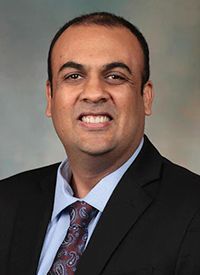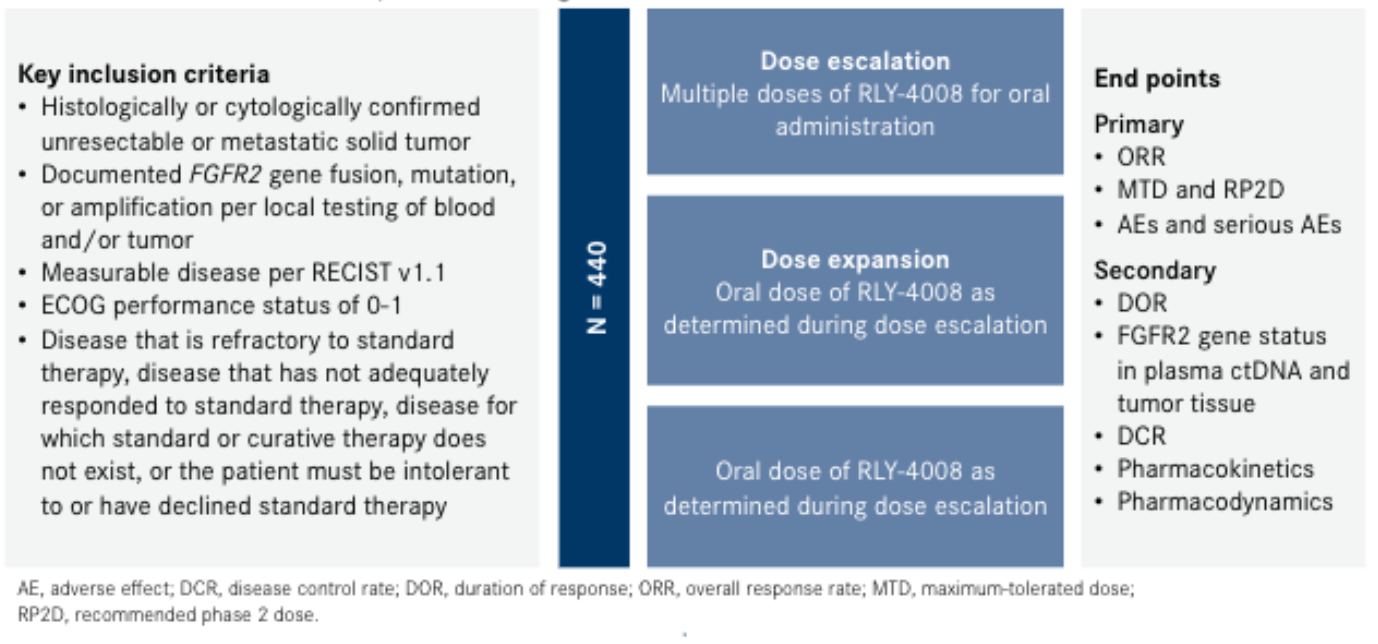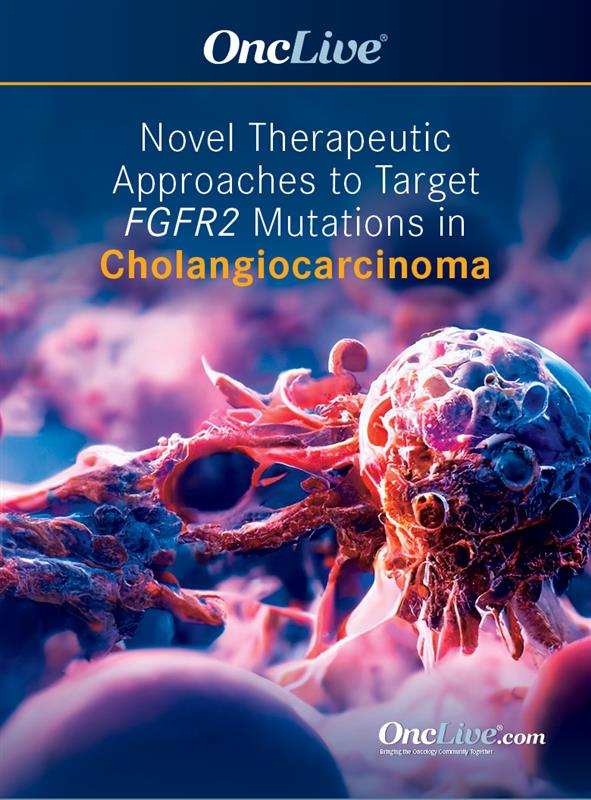Publication
Article
Investigators Seek to Refocus on FGFR2-altered Cholangiocarcinoma
Author(s):
Investigators hope to add RLY-4008, the first highly selective FGFR2 inhibitor, to the growing arsenal of treatment options for patients with cholangiocarcinoma.
Mitesh J. Borad, MD

Treatment options for the management of patients with cholangiocarcinoma are rapidly expanding with multiple approved targeted therapies and immunotherapy. Investigators hope to add RLY-4008, the first highly selective FGFR2 inhibitor, to this growing arsenal of treatment options with the initiation of the phase 1/2 ReFocus trial (NCT04526106).1
Cholangiocarcinoma is considered a rare disease with a poor prognosis and effective treatment options begin to decline as later lines of therapy are introduced. Frontline treatment with gemcitabine/cisplatin with or without durvalumab leads to a median overall survival (OS) of approximately 1 year. Second-line treatment with FOLFOX has historically resulted in a median OS of approximately 6 months. FGFR2 fusions or rearrangements have been shown to drive approximately 10% to 15% of intrahepatic cholangiocarcinoma (ICC) cases.2
“Available agents [in the cholangiocarcinoma space] have historically relied on cytotoxic chemotherapy,” Mitesh J. Borad, MD, an oncologist at Mayo Clinic in Phoenix, Arizona, said in an interview with OncologyLive®. “With the advent of the TOPAZ-1 [NCT03875235] data, we now have durvalumab also in the tool kit in the first-line setting. [Additionally], there are a whole host of therapies in the targeted therapy setting. These have primarily been used in the beyond first-line setting and have been restricted currently to FGFR2 fusions and IDH1 mutations as disease specific targets.”
RLY-4008 is designed to selectively inhibit FGFR2, specifically via its unique conformational dynamics. The agent has displayed potent in vivo antitumor activity in disease harboring primary FGFR2 alterations, in addition to other common resistance mutations.3
“First-line treatment with gemcitabine and cisplatin chemotherapy has significant toxicity and limited efficacy with a median progression-free survival of 6 to 8 months and an overall survival of less than 8 months,” said Antoine Hollebecque, MD, head of the conventional hospital in the Drug Development Department at Gustave Roussy Cancer Center in Villejuif, France, during the European Society of Medical Oncology Annual Congress 2022.
In further preclinical study, RLY-4008 led to a biochemical half maximal inhibitory concentration (IC50) of 864.3, 3.1, 274.1, and 17,633 in FGFR1, FGFR2, FGFR3, and FGFR4, respectively. Futibatinib, an irreversible pan-FGFR inhibitor, has demonstrated the ability to elicit an IC50 of less than 2 in FGFR1, FGFR2, and FGFR3, and an IC50 of approximately 3.7 in FGFR4. Similarly, the reversible pan-FGFR inhibitor infigratinib displayed an IC50 between 1 and 2 in FGFR1, FGFR2, and FGFR3, and an IC50 of 61 in FGFR4.2,3
RLY-4008 displays efficacy in FGFR2+ cholangiocarcinoma
ReFocus is a phase 1/2 open-label study evaluating of RLY-4008 for the treatment of patients with ICC and other advanced solid tumors. Patients must have FGFR2 alterations, an ECOG performance status of 1 or less, and disease that is refractory to standard therapy, not responsive to standard therapy, or lacking a standard therapy (Figure).
Figure. ReFocus Phase 1/2 Trial Design

Patients with central nervous system metastases or a primary central nervous system tumor associated with progressive neurologic symptoms are ineligible for the trial. Patients who lack adequate organ function, have clinically significant FGFR inhibitor–induced retinal detachment or an ongoing clinically significant corneal or retinal disorder, and patients with an active infection are also excluded from the study.
The primary end points of the study are objective response rate (ORR) of RLY-4008, and safety. Secondary end points include duration of response, disease control rate, and pharmacokinetics.
In the dose escalation portion of the trial, investigators noted that RLY-4008 displayed a predicted median receptor occupancy of at least 85% across all dose levels. The agent exhibited a half-life of approximately 15 hours to 30 hours, which supported daily dosing. The RP2D of oral RLY-4008 was determined to be 70 mg daily and the maximum-tolerated dose was not reached per protocol.2,3
“Together these data indicate that RLY-4008 targets FGFR2 without inducing FGFR1-related hyperphosphatemia,” Hollebecque said. “Early ReFocus data validate this novel mechanism of action and support expedited development [of the agent].”
Investigators presented additional preliminary findings from the FGFR2 fusion or rearrangement, FGFR inhibitor-naïve cholangiocarcinoma cohort of the ReFocus trial during the ESMO Congress 2022. They noted that RLY-4008 is showing great promise in the space and has the potential to shift the treatment landscape in patients with cholangiocarcinoma harboring an FGFR2 fusion or rearrangement who have not previously received treatment with an FGFR inhibitor.
“RLY-4008 is the first highly selective, irreversible inhibitor designed to target oncogenic FGFR2 driver alterations and resistance mutations,” Hollebecque said. “These results suggest that RLY-4008 has the potential to transform the cholangiocarcinoma treatment paradigm and strongly support seamless expansion of ReFocus with registrational intent.”
Efficacy-evaluable patients treated at all dose levels (n= 38) achieved an ORR of 63.2% (95% CI, 46%-78.2%). Stable disease was observed in 31.6% of patients and 5.3% experienced disease progression. The disease control rate (DCR) was 94.7% (95% CI, 82.3%-99.4%). At the data cutoff, a response was ongoing in 79.2% of patients and 68.4% remained on treatment.
The median time to response was 1.8 months. The median duration of exposure to RLY-4008 was 5.5 months (range,<0.1-18.5).
Notably, patients treated at the RP2D (n=17) performed even better in terms of ORR; the ORR in this group was 88.2% (95% CI, 63.6%-98.5%). All responses were partial, including 1 patient with an unconfirmed partial response. The DCR was 100% (95% CI, 80.5%-100%) and 11.8% oof patients experienced stable disease. All patients in this cohort were experiencing an ongoing response at the time of the data cutoff and 88.2% remained on treatment.
“These are early data, that is something to keep in mind,” Borad said, “but they are quite provocative and promising.”
The median age in the FGFR2 fusion or rearrangement, FGFR inhibitor-naïve cohort who received any dose level was 58 years (range, 33-81). Most patients were females (58%) and ECOG performance status was split evenly between 0 and 1. One prior line of systemic therapy was used in 47% of patients, 2 and 3 or more were used in 32% and 21%, respectively.
In the cohort that received the RP2D, the median age was 57 years (range, 36-81) and most patients were females (59%). A majority of patients in this cohort had an ECOG performance status of 0 (53%). Forty-one percent of patients underwent prior treatment with a single line of treatment, 47% received 2 prior lines, and 12% were treated with 3 or more prior lines.
In terms of safety, patients in the safety population who received the RP2D (n=89) experienced a treatment-related adverse event (TRAE) that led to dose interruption or dose reduction at a rate of 42% and 27%, respectively. Only 1 patient discontinued treatment with RLY-4008 because of a TRAE.
Commonly occurring TRAEs of any grade occurring at the RP2D included nail toxicities (43%), stomatitis (42%), and palmar plantar erythrodysesthesia syndrome (35%). Grade 3 TRAEs were less common, consisting only of stomatitis (8%), palmar plantar erythrodysesthesia syndrome (8%), and nail toxicities.
Comparatively, patients in the safety population treated with RLY-4008 at any dose level (n=195) experienced TRAE-related dose interruptions, reductions, and discontinuations at a rate of 47%, 3%, and 1%, respectively. The most common any grade TRAEs included stomatitis (48%), nail toxicities (46%), palmar plantar erythrodysesthesia syndrome (46%), and dry mouth (31%). Grade 3 TRAEs were limited to palmar plantar erythrodysesthesia syndrome (15%), stomatitis (8%), and nail toxicities (2%).
Investigators noted that, overall, the adverse effects observed with RLY-4008 were low-grade, manageable, and largely reversible. This is indicative of selective FGFR2 inhibition accompanied by sparing of FGFR1 and FGFR4, they wrote.
“The key [next steps] will be a larger cohort of patients compared with what was presented,” Borad said. “I am sure there will be updates over time as more data is accumulated in a larger group of patients. I will eagerly await [seeing] if the initial response rates that have been observed hold up, or if there’s some diminishment, like we typically see when we have larger groups of patients. But given how high [the ORR] is, we will really want to keep an eye out and see where the final numbers end up.”
The trial is open to enrollment.
References
- REFOCUS: A first-in-human study of highly selective FGFR2 inhibitor, RLY-4008, in patients with ICC and other advanced solid Tumors. clinicalTrials.gov. Updated July 11, 2022. Accessed September 29, 2022. https://clinicaltrials.gov/ct2/show/NCT04526106?term=RLY-4008&draw=2&rank=1
- Hollebecque A, Borad M, Goyal L, et al. Efficacy of RLY-4008, a highly selective FGFR2 inhibitor in patients (pts) with an FGFR2-fusion or rearrangement (f/r), FGFR inhibitor (FGFRi)-naïve cholangiocarcinoma (CCA): ReFocus trial. Ann Oncol. 2022;33(suppl 7):S808-S869. doi:10.1016/annonc/annonc1089
- Goyal L, Borad M, Subbiaj V, et al. First results of RLY-4008, a potent and highly selective FGFR2 inhibitor in a first-in-human study in patients with FGFR2-altered cholangiocarcinoma and multiple solid tumors. Mol Cancer Ther. 2021;20(suppl 12):P02. doi:10.1158/1535-7163.TARG-21-P02-02










